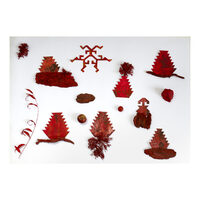How to Turn Red (2/2)
Item
-
Title
-
How to Turn Red (2/2)
-
Format
-
en
JPG
-
Date
-
2021
-
Description
-
Artwork created and submitted in the context of the ECHO II project which was dedicated to inviting artists in residence to create original artworks, inspired by selected local traditions
-
Type EDM
-
en
Image
-
Rights
-
This work is licensed under a Creative Commons Attribution-NonCommercial 4.0 International License.
-
Extent
-
Various dimensions
-
Digitisation equipment
-
Equipment used: Cameras: Canon 5D Mark IV, Canon 6D | Camera Type: DSLR | Lenses: Canon EF 24-70mm f/2.8L II USM, Canon EF 16-35mm f/2.8L II USM, Canon EF 85mm f/1.8 USM. Image processing software: Adobe Photoshop 22.4 (Windows). Digitisation of artwork: Panagiotis Diapoulis
-
Bibliographic Citation
-
“How to Turn Red (2/2)”. 2021. Artist: Beáta Méry. Source: https://echo-heritage.eu/myomekas/s/repository/item/1607. License: CC BY-SA 4.0.
-
Statement of Responsibility
-
The art residency has been co-funded by the European Union and is part of the project ECHO II - Traditions in Transition, Creative Europe Programme. The artwork was produced with the financial support of the European Union. Its contents are the sole responsibility of its creators and do not necessarily reflect the views of the European Union.
-
Abstract
-
Beáta was creating and changing the installation in parallel to her work on the three canvases. She was collecting and painting the branches, lychee, and parts of tree bark in red colour. There appeared the elements of the embroidery as well, the main one transformed by the artist herself and used in her triptych, then one more, then an interesting rotation of additionally styled figure of the Mother Goddess — an anthropomorphic motif from the Bulgarian embroidery.
The spatial figure developed on the basis of the main motif is the most attractive element. In its voluminous variant, however, it receives a new reading and a new meaning. The similarity with the coniferous tree is decreasing displaced by the similarity with a fir cone- an interesting figure, one more of the natural manifestations registered by the phenomenal numbers of Fibonacci. The other association is with human creations such as the constructions of the Egyptian temples “mastaba” and the ladder-like pyramids in Egypt and Latin America. Putting a mirror at the bottom, Beáta transforms the inner space and challenges the viewer to look inside where, on the inner walls of the figure, the text of the poem “Fire” by Laslo Nagi is written in both Hungarian and Bulgarian. The artist herself participates in the next transformation, peering naughtily from one of the holes in the figure, turning her into a kind of obscure camera.
Gathered together, all those things create their own space united by the red colour and by the idea to change their usual use and to create new combinations between each other in order to narrate a new story — about the mountain, the people, the preserved traditions, and about the creators who give them new life.
 How to Turn Red (2/2)
How to Turn Red (2/2)
